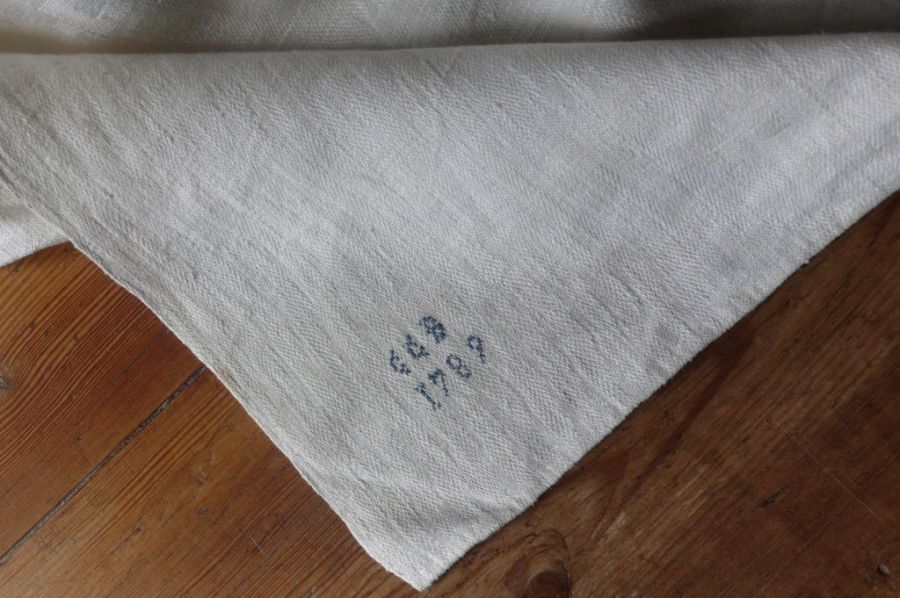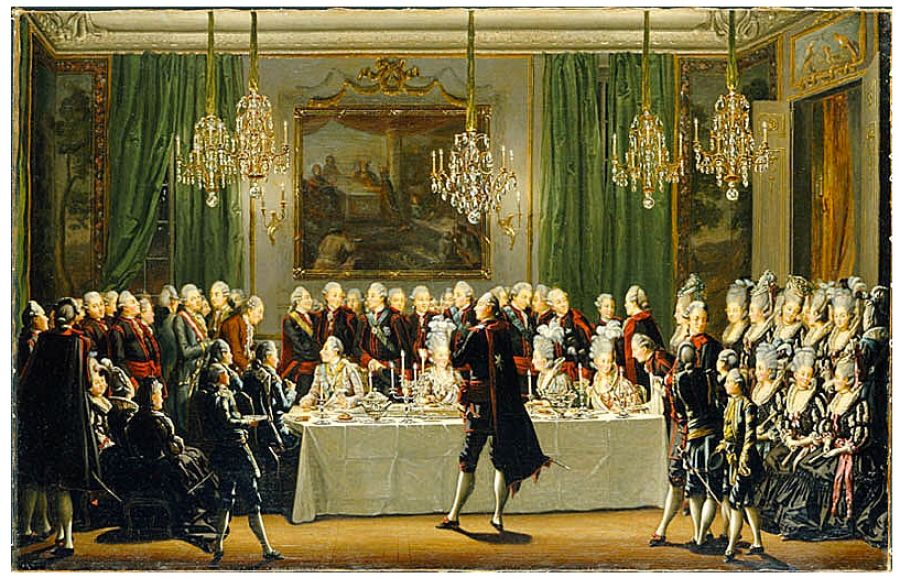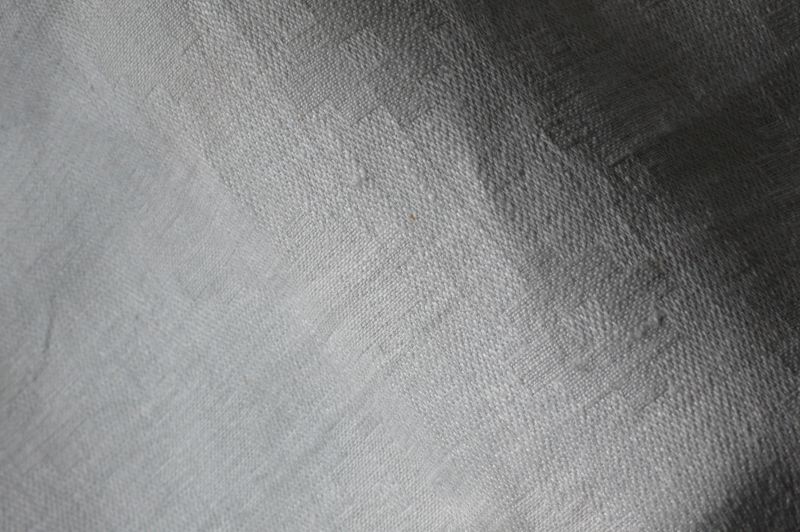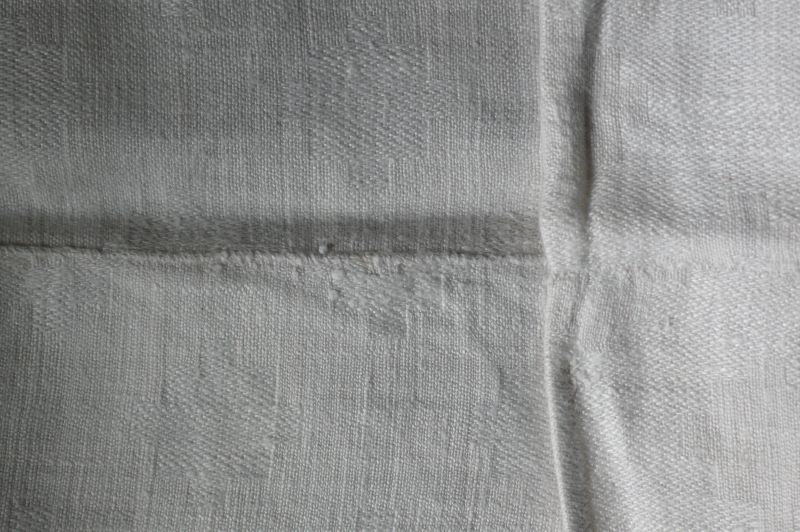ikfoundation.org
The IK Foundation
Promoting Natural & Cultural History
Since 1988


 Crowdfunding Campaign
Crowdfunding Campaignkeep knowledge open, connected, and growing on this textile history resource...
THE HISTORY OF A LINEN TABLECLOTH
– Dated 1789
To own a substantial number of unbleached or white linen tablecloths in a Swedish nobility home, was a tradition with its roots in Medieval times. This group of interior textiles also represented an important part of the family linen storage and as a valuable heirloom – a practice that continued for several hundreds of years. The aim of this historical essay is to describe a well-preserved six-metre-long linen tablecloth dated “1789”, where the original owners belonged to families of barons and counts. Unfortunately, there are no clues as to who or where this tablecloth once was woven, but possibly at one of the leading linen weaving manufacturers in Sweden, such as Flor, Vadstena, or one of the early factories for such goods in Stockholm.
 One of the corners is added with ‘CCB 1789’ in small cross stitches using grey-blue linen thread, the letters refer to Charlotta Catharina Bielke (1765-1793). She married the year before the dating of this tablecloth – 29 January in 1788 – with Louis de Geer af Leufsta (1759-1830). (Private ownership) Photo: The IK Foundation, London.
One of the corners is added with ‘CCB 1789’ in small cross stitches using grey-blue linen thread, the letters refer to Charlotta Catharina Bielke (1765-1793). She married the year before the dating of this tablecloth – 29 January in 1788 – with Louis de Geer af Leufsta (1759-1830). (Private ownership) Photo: The IK Foundation, London.This fine tablecloth is woven in twill diaper with hand-spun linen thread in both the warp and weft; the regular pattern of the fabric was designed with an eleven centimetres wide contrasting border. As with all hand-loom or half-mechanised manufacturing of the time in Sweden, a tablecloth consisted of two widths and these pieces of fabric were sewn together with a middle seam. It must also be emphasised that a tablecloth of this size becomes heavy, which would lead to strenuous work for several of the servants employed to do the laundering of such a large linen.
 A contemporary painting depicting how a linen tablecloth of this standard was used. One can reflect that the extensive width as well as length of the fabric was necessary for the tablecloth to reach the floor at all four sides of the elegantly laid table. Oil on canvas by Pehr Hilleström – ‘Stockholm Palace New Year’s Eve 1779’. Courtesy of: The National Museum, Sweden (Wikimedia Commons).
A contemporary painting depicting how a linen tablecloth of this standard was used. One can reflect that the extensive width as well as length of the fabric was necessary for the tablecloth to reach the floor at all four sides of the elegantly laid table. Oil on canvas by Pehr Hilleström – ‘Stockholm Palace New Year’s Eve 1779’. Courtesy of: The National Museum, Sweden (Wikimedia Commons).A comparative study of linen tablecloths from the higher nobility of the period can, for example, be observed in my earlier research of a document originating from Christinehof Manor house in southernmost Sweden in 1758. This inventory included 41 linen tablecloths of various qualities, together with 539 napkins. The most complex design is described as ‘His Excellency’s Arms woven into…’ in ‘Damask diaper with 24 napkins’. Furthermore, ‘3 tablecloths and 18 napkins’ were registered of the same weaving technique. Additionally, it can be noted that the majority of the linen fabrics were marked with ‘C’ and the years ’54’, ’57’ or ’58’ [in the 1750s] referring to the tenant in tail, who at the time was Carl Fredrik Piper (1700-1770). Listed patterns in the inventory included ‘Night and Day motif ’, ‘The French rose’ and ‘Fortification pattern’ – all woven in variations of diaper or damask with geometric patterning and a wide border with contrasting designs. Just like the tablecloth dating from 1789 as discussed in this text. [Quotes in this section are translated from Swedish into English].
 Compared to many other tablecloths of the time woven in the advanced damask technique, this cloth of twill diaper was less demanding, even if a lot of knowledge in weaving was required to reach a perfect result. At a closer study it is easy to conclude that a trained female or male weaver once produced this cloth, the weave is uniformly and exact in every detail, woven on a loom width of at least 1,35 m (2 widths = 2,66m) with a warp density of circa 20 threads/cm. (Private ownership) Photo: The IK Foundation, London.
Compared to many other tablecloths of the time woven in the advanced damask technique, this cloth of twill diaper was less demanding, even if a lot of knowledge in weaving was required to reach a perfect result. At a closer study it is easy to conclude that a trained female or male weaver once produced this cloth, the weave is uniformly and exact in every detail, woven on a loom width of at least 1,35 m (2 widths = 2,66m) with a warp density of circa 20 threads/cm. (Private ownership) Photo: The IK Foundation, London. It is unusual for this sort of large size linen tablecloth to have been preserved for so long without being shortened, adjusted or laundered in an unsuitable way. On this close-up it is also possible to study how beautifully the middle seam is finished off – both on the front and back. The tablecloth measuring exactly 6,00 x 2,66 meters and is quite heavy too, weighing just over five kilos or 11 pounds! (private ownership) Photo: The IK Foundation, London.
It is unusual for this sort of large size linen tablecloth to have been preserved for so long without being shortened, adjusted or laundered in an unsuitable way. On this close-up it is also possible to study how beautifully the middle seam is finished off – both on the front and back. The tablecloth measuring exactly 6,00 x 2,66 meters and is quite heavy too, weighing just over five kilos or 11 pounds! (private ownership) Photo: The IK Foundation, London.This tablecloth was a gift from my friend, the Ex-chief inspector for historical buildings & monuments, former Director of the IK Foundation Carl-Filip Mannerstråle (1924-2002), Araslöv 1992 (the tablecloth was inherited through several generations in his family).
Sources:
- Hansen, Viveka, Inventariüm uppå meübler och allehanda hüüsgeråd sid Christinehofs Herregård upprättade åhr 1758, Christinehof 2004.
- Oral information about the origin of the tablecloth in 1992, from Carl-Filip Mannerstråle.
Essays
The iTEXTILIS is a division of The IK Workshop Society – a global and unique forum for all those interested in Natural & Cultural History.
Open Access Essays by Textile Historian Viveka Hansen
Textile historian Viveka Hansen offers a collection of open-access essays, published under Creative Commons licenses and freely available to all. These essays weave together her latest research, previously published monographs, and earlier projects dating back to the late 1980s. Some essays include rare archival material — originally published in other languages — now translated into English for the first time. These texts reveal little-known aspects of textile history, previously accessible mainly to audiences in Northern Europe. Hansen’s work spans a rich range of topics: the global textile trade, material culture, cloth manufacturing, fashion history, natural dyeing techniques, and the fascinating world of early travelling naturalists — notably the “Linnaean network” — all examined through a global historical lens.
Help secure the future of open access at iTEXTILIS essays! Your donation will keep knowledge open, connected, and growing on this textile history resource.
been copied to your clipboard




– a truly European organisation since 1988
Legal issues | Forget me | and much more...
You are welcome to use the information and knowledge from
The IK Workshop Society, as long as you follow a few simple rules.
LEARN MORE & I AGREE







